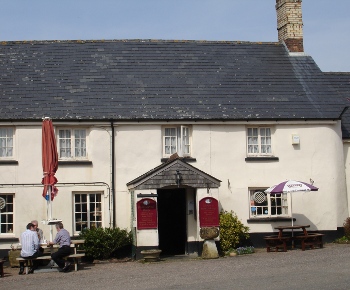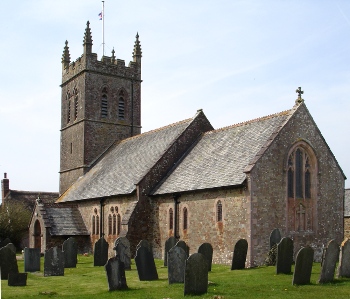
Undoubtedly Sheepwash has many of the attributes that typify the charm of a Devon village: the cob and thatch cottages, the village square with a friendly inn, and the church with its imposing tower. In the words of Margaret Waddingham in the first paragraph of her sympathetic monograph on the village:



At the heart of the village is an attractive open square. The church tower dominates the skyline behind the comely thatched roofs at the far end of the square which is bordered on its northern edge by the popular Half Moon Inn that provides facilities for fishing on the nearby River Torridge.
Opposite the square is the village store and Post Office that has been run by the same family for many generations.
Given the air of tranquillity that pervades the village today, it is hard to imagine that in 1836 it was the scene of a riot over the workings of the new Poor Law in which several hayricks were set alight. The five ringleaders were taken to Exeter gaol under guard of the North Devon Yeomanry despite the efforts of a hostile crowd to free them. They were each jailed for three months.
From the Middle Ages until the the fire of 1743 which ravaged much of the village, Sheepwash market was perhaps the most important of its kind in all of North Devon. The hub of the market was the livestock auction which took place in the yard behind the Half Moon Inn.

After the great fire in 1743, the village remained largely empty for as long as 10 years, or so it is said, and the sale of livestock moved to the larger towns of Holsworthy to the west and Hatherleigh about 5 miles to the east. The market eventually returned to the village, but it never regained its former reputation. Until the end of the 18th century there was a weekly market on Mondays augmented by a fair each Spring and Autumn, while by the 19th century the market was held once a month before being discontinued. It was re-started in the 1920s and continued until the 1950s when it closed for the last time with the demise of the drover. The old photo from circa 1950 shows just how busy it was on market day even then.

The Church of St Lawrence in Sheepwash is the third to have been built on the same site since the 14th century: the second incarnation erected after the collapse of the original edifice was destroyed by fire. A notice engraved in stone near the entrance reveals that the present church was rebuilt in 1880. This was at a cost of £1600 borne by the then lord of the manor, Lord Clinton, or Charles Henry Rolle Hepburn-Stuart-Forbes-Trefusis, 20th Baron Clinton to his friends. The pinnacled tower was completed in 1889 at a further cost of £300.
Many of the furnishings of the church including the splendid stained glass east window and the solid oak lectern in the shape of an eagle were presented by an individual benefactor,
Sheepwash Bridge across the Torridge to the south of the village was built in the 17th century. After the only son of the wealthy local landowner John Tosbury was swept away while crossing the ford when the river was in spate, his grief-stricken father underwrote the building and maintenance of a bridge in memory of his drowned son.
By 1695 trustees had been appointed to secure the upkeep of the bridge. As the income from the Tosbury estates proved more than sufficient to maintain the bridge, John gave instructions that the surplus be used for the benefit of the people of Sheepwash. So the Bridgeland Trust was born and to this day it provides for deserving cases of hardship in the community, as well as going towards the upkeep of the church and chapel.


To the east of Sheepwash close by the River Torridge stands the manor house of Totleigh Barton whose origins go back to the 11th century. Today this attractive thatched house is one of four venues that has been used as a retreat by the Arvon Foundation for their creative writing courses since 1968. My wife has fond memories of a poetry course she attended there in the summer of 1978. Gavin Ewart was the tutor, with appearances by two celebrated English poets, Ted Hughes and Charles Causley.